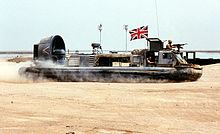
A hovercraft, also known as an air-cushion vehicle or ACV, is an amphibious craft capable of travelling over land, water, mud, ice, and various other surfaces.

The Finnish Border Guard is the agency responsible for enforcing the security of Finland's borders. It is a military organisation, subordinate to the Ministry of the Interior in administrative issues and to the president of Finland in issues pertaining to his authority as Commander-in-Chief. The agency has police and investigative powers in immigration matters and can independently investigate immigration violations. The Finnish Coast Guard has search and rescue (SAR) duties, both maritime and inland. Missions inland are often carried out in co-operation with local fire and rescue departments or other authorities.

The Patrol Air Cushion Vehicle (PACV), also known as the Air Cushion Vehicle (ACV) in Army and Coast Guard service, was a United States Navy and Army hovercraft used as a patrol boat in marshy and riverine areas during the Vietnam War between 1966 and 1970. Six hovercraft were built, three for the Army and three for the Navy.

The Polish Border Guard is a state security agency tasked with patrolling the Polish border. It existed in the Second Republic era from 1928 to 1939 and was reestablished in the modern-day Third Republic in 1990, going into operation the following year. During the communist era lasting from 1945 to 1989, the role of the border guard was carried out by the Border Protection Troops.
Hovertravel is a ferry company operating from Southsea, Portsmouth to Ryde, Isle of Wight, UK. It is the largest passenger hovercraft company currently operating in the world since the demise of Hoverspeed.
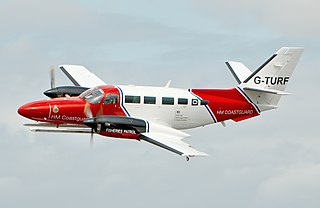
The Reims-Cessna F406 Caravan II is a turboprop twin engine utility aircraft manufactured and designed by Reims Aviation in cooperation with Cessna.

Griffon Hoverwork Ltd (GHL) is a British hovercraft designer and manufacturer.
Seaspeed was a British hovercraft operator which ran services in the Solent and English Channel between 1965 and 1981, when it merged with a rival to form Hoverspeed.
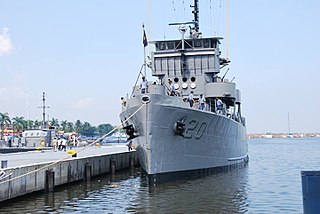
BRP Magat Salamat (PS-20) is one of several Miguel Malvar class of patrol corvettes in service with the Philippine Navy. She was originally built as USS Gayety (AM-239), an Admirable-class minesweeper with a similar hull to the PCE-842-class patrol craft produced during World War II. In 1962 she was transferred to South Vietnam for service in the Republic of Vietnam Navy as RVNS Chi Lang II (HQ-08). She was acquired by the Philippine Navy in April 1976 and later on commissioned as Magat Salamat. Along with other ex-World War II veteran ships of the Philippine Navy, she is considered one of the oldest active fighting ships in the world today.

BRP Sultan Kudarat (PS-22) was a Miguel Malvar-class corvette of the Philippine Navy. It was originally built as USS PCE-881, a PCE-842-class patrol craft for the United States Navy during World War II. In 1961 it was transferred to South Vietnam for service in the Republic of Vietnam Navy as RVNS Đống Đa II (HQ-07). It was acquired by the Philippine Navy in April 1976, and was commissioned later on as RPS Sultan Kudarat (PS-22). Along with other World War II-era ships of the Philippine Navy, Sultan Kudarat was considered one of the oldest active fighting ships in the world, until its retirement in July 5, 2019.

The Saunders-Roe SR.N6 hovercraft was essentially a larger version of the earlier SR.N5 series. It incorporated several features that resulted in the type becoming one of the most produced and commercially successful hovercraft designs in the world.

The British Hovercraft Corporation AP1-88 is a medium-size hovercraft. In a civil configuration, the hovercraft can seat a maximum of 101 passengers, while as a troop carrier, it can transport up to 90 troops. When operated as a military logistics vehicle, the AP1-88 can carry a pair of Land Rovers, a Bv202 tracked vehicle and trailer unit or up to roughly 10 tons (10,000 kg) of cargo.
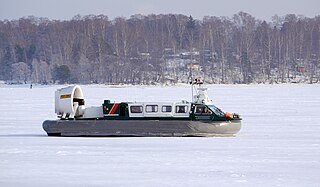
The Slingsby SAH 2200 hovercraft is a small military hovercraft designed and originally produced by the Slingsby Amphibious Hovercraft Company at their facility in Kirkbymoorside, England.

The British Hovercraft Corporation BH.7 is a medium size hovercraft. It was the first quantity-production hovercraft to be specifically developed for military applications.
CCGS Penac was a Canadian Coast Guard AP1-88/100 air cushioned vehicle (ACV) or hovercraft and was based at CCG Hovercraft Base Richmond, British Columbia. The primary missions of Penac was search and rescue off the British Columbia Coast. The vessel was initially constructed in 1984 by the British Hovercraft Corporation for use as a passenger vessel in Copenhagen, Denmark as Lommen with Scandinavian Airlines and renamed Liv Viking just before the service began. Sold in 1997 after a bridge eliminated the vessel's need, the hovercraft was sold to Hovertravel for service on the Solent. However, the ACV never entered service and was acquired by the Canadian Coast Guard in 2004. Renamed Penac, the hovercraft remained in service until 2017.
CCGS Mamilossa is a Canadian Coast Guard Hoverwork AP1-88/400 air cushioned vehicle or hovercraft based at CCG Hovercraft Base Trois-Rivières, Quebec. The first of three hovercrafts of the AP1-88/400 design ordered by the Canadian Coast Guard, Mamilossa was the only one constructed in the United Kingdom by Hoverworks Ltd. with the remaining units, CCGS Sipu Muin and CCGS Siyay, built under license by Hike Metal Products of Wheatley, Ontario, Canada. Mamilossa is the largest hovercraft exported by British shipbuilders and was launched in 2008. The hovercraft's name is Abenaki for "it walks from the shore onto the water fair winds". The hovercraft entered service in 2009.
Swallow Craft Class of Inshore Patrol Vessels are a series of watercraft built by South Korea's Kangnam/Swallow Craft, in Pusan for the Indian Coast Guard.

Griffon/GRSE 8000 TD class is a series of hovercraft designed by Griffon Hovercraft Ltd, Southampton, England. It has proven to be one of Griffon's most commercially successful hovercraft.

The San Juan-class patrol vessel consists of four vessels built by the Australian shipbuilding company Tenix for the Philippine Coast Guard. They were commissioned from 2000 to 2003. Their hull number prefix "SARV" means they are classified by the coast guard as "search and rescue vessels". They specialize in and are designed for search and rescue and other maritime emergencies. It is reported that the ships have fallen into disrepair. Currently Non operational.
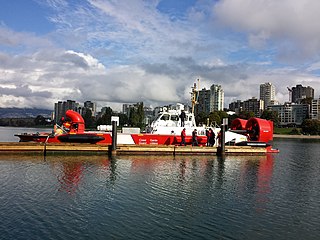
CCGS Moytel is a Canadian Coast Guard air cushioned vehicle or hovercraft and is based at CCG Hovercraft Base Richmond, British Columbia, on Sea Island. The primary mission of Moytel is to provide search and rescue services for British Columbia.


